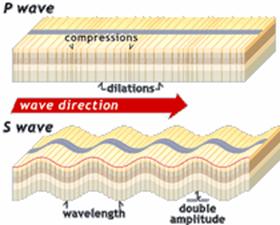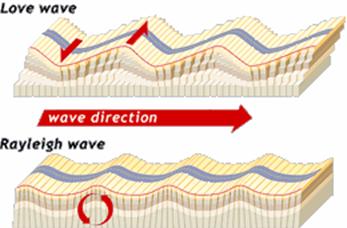Curriculum
Back to Background Material
Seismic Waves
When an earthquake occurs, it releases energy in the form of waves that radiate from the earthquake source in all directions. The different types of energy waves shake the ground in different ways and also travel through the earth at different velocities. (Also described in Panel text, pg. 4.)
P-Wave : The fastest wave, and therefore the first to arrive at a given location, is called the P-wave (primary or push-pull). The P-wave alternately compresses and expands material in the same direction it is traveling. At depths of less than 25 kilometers (16 miles), compressional waves travel at about 6.8 kilometers (4.2 miles) per second. They can travel completely through the planet. When they reach the surface they cause vertical shaking.

Drawing by David Barker: http://www.exploratorium.edu/faultline/earthquakescience/eqscience4.html
S-wave : The S-wave (secondary, shear, or side-to-side wave) is slower than the P wave and arrives next, shaking the ground up and down and back and forth perpendicular to the direction it is traveling. Shear waves travel at 3.8 kilometers (2.4 miles) per second.
Body waves travel faster deep within the earth than near the surface. At a depth of 1,000 kilometers (620 miles), the waves travel more than 1 1 / 2 times that speed. S-waves cannot travel through liquids. When they reach the surface they cause horizontal shaking.
Detailed explanation of why S-waves don't travel through liquids
Liquids don't have any shear strength and so a shear wave cannot propagate through a liquid. Think of a solid material, like a rock. That rock is made up of atoms and molecules bound to each other. When you set the rock down, its molecules and atoms stay in place and the rock holds it shape. This is because those bonds between the atoms and molecules have a certain amount of shear strength and they can resist the pull of gravity and stay together.
Now imagine that you have a glass of water. If you put the glass of water on the table and then somehow remove the glass, the water will not hold its shape. Instead it will flow away along the surface of the table. This is because water (and most other liquids) do not have shear strength - there are no bonds holding the water molecules together that will resist a shear force. Surface Waves: When the energy of a quake reaches the surface of the earth, it creates two types of surface waves, each named for its discoverer: Rayleigh waves churn over and under like rolling ocean waves; Love waves make flattened round-and-round motions, like the ones you make rubbing suntan lotion on a sunbather's back. Though these waves move more slowly than P or S waves, they are much more destructive -- particularly Love waves, which are the ones often responsible for making buildings collapse.

Drawing by David Barker: http://www.exploratorium.edu/faultline/earthquakescience/eqscience4.html
|

